

www.rwjbh.org



www.rwjbh.org

As New Jersey’s largest academic health system, RWJBarnabas Health has a mission to partner with our communities to build and sustain a healthier New Jersey. This commitment does not begin and end with a visit to a doctor or a hospital. It starts with proactively addressing social factors that have an impact on health equity and outcomes.
We ensure access to healthy food and affordable medications, create educational and economic opportunities, promote safe and affordable living conditions and expand access to primary care. We are working with community partners on innovative ways to address those factors well before our patients need medical care.
We funded construction of a new public elementary school and offer a variety of career-path programs for students, and subsidize affordable housing. We also help increase access to healthy food in our communities by distributing tens of thousands of meals, supporting local community gardens and providing nutritional education throughout the state.
RWJBarnabas Health is in and of the communities we serve. Our anchor mission to hire local/buy local has led to recruitment of more than 3,000 team members from asset-limited, income-constrained neighborhoods and injected millions of dollars into local communities.
Being an anchor institution of our great state is an honor and a privilege, and we thank the residents of New Jersey for trusting RWJBarnabas Health to care for them in every sense of the word.
Sincerely,
MARK E. MANIGAN PRESIDENT AND CHIEF EXECUTIVE OFFICER
RWJBarnabas Health complies with applicable federal civil rights laws and does not discriminate on the basis of race, color, national origin, age, disability or sex. For more information, see the link on our home page at www.rwjbh.org.
RWJBarnabas Health provides free language services, including qualified interpreters, to people whose primary language is not English. The following Language Assistance Services information is provided in multiple languages.
ESPAÑOL
ATENCIÓN: Si habla español, tiene a su disposición servicios gratuitos de asistencia lingüística.
Llame al 1.844.465.9474
繁體中文
注意:如果您使用繁體中文,您可以免費 獲得語言援助服務。
致电1.844.465.9474
한국어 주의: 한국어를 사용하시는 경우, 언어 지원 서비스를 무료로 이용하실 수 있습니다. 1.844.465.9474 로 전화하십시오.
PORTUGUÊS
ATENÇÃO: Se fala português, encontram-se disponíveis serviços linguísticos, grátis. Ligue para 1.844.465.9474 ગુજરાતી
જો
POLSKI
UWAGA: Jeżeli mówisz po polsku, możesz skorzystać z bezpłatnej pomocy językowej. Zadzwoń pod numer 1.844.465.9474
ITALIANO
ATTENZIONE: In caso la lingua parlata sia l’italiano, sono disponibili servizi di assistenza linguistica gratuiti. Chiamata 1.844.465.9474
CONNECT WITH US
@RWJBarnabasHealth
@RWJBarnabas
RWJBarnabas Health
RWJBarnabas_Health
linkedin.com/company/
RWJBarnabasHealth
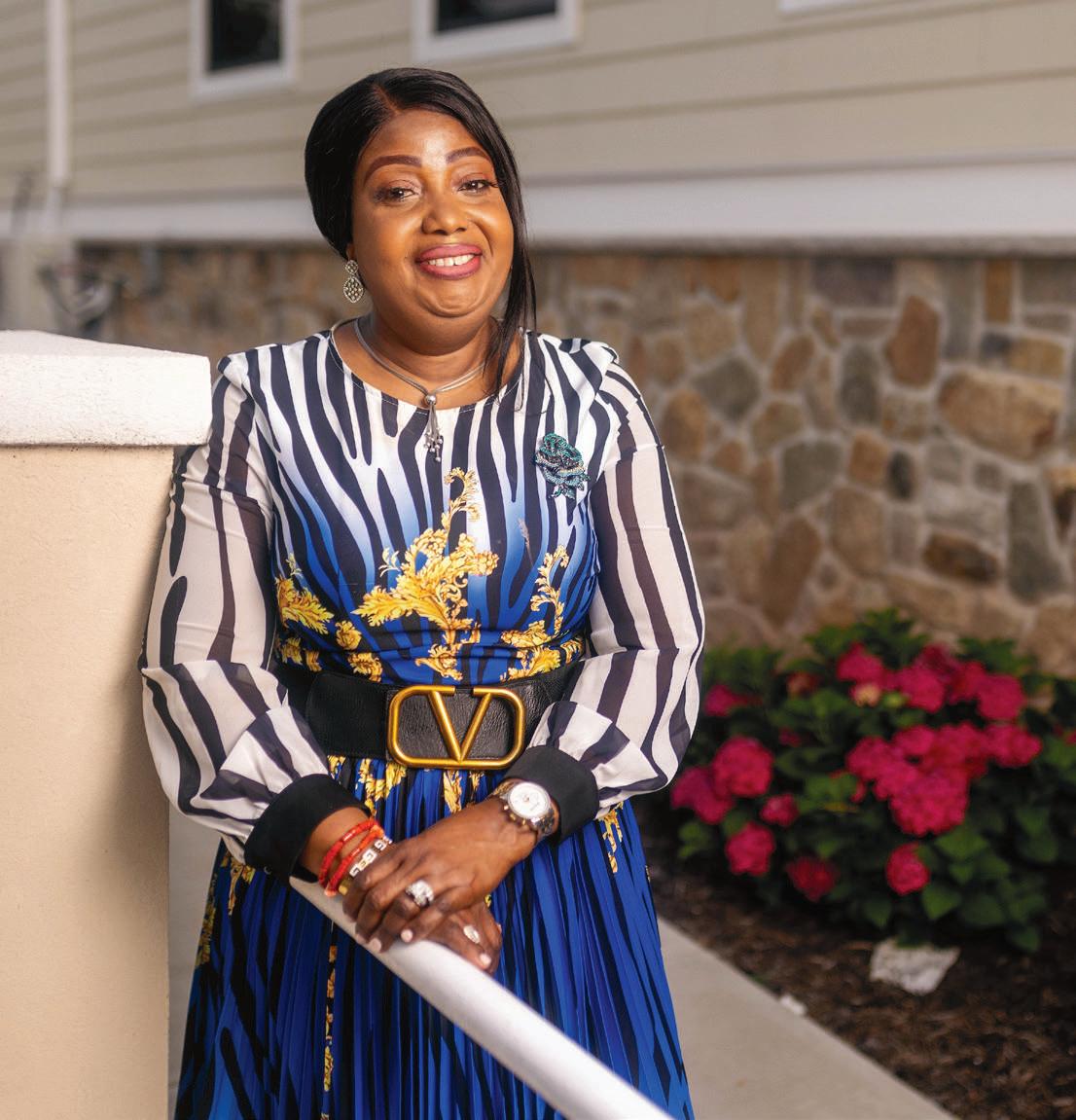
2. WELCOME LETTER. A community update from our President and Chief Executive Officer.
4. ‘INVISIBLE’ HEART ATTACKS— REVEALED. New technology finds a danger common in women.
6. TOUGH CANCERS, NEW ANSWERS. Targeted treatments help a woman beat lung cancer.
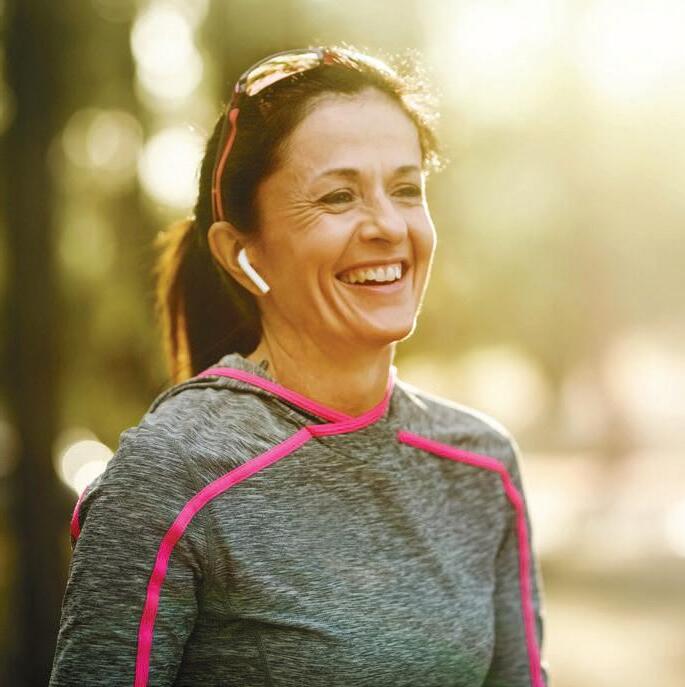
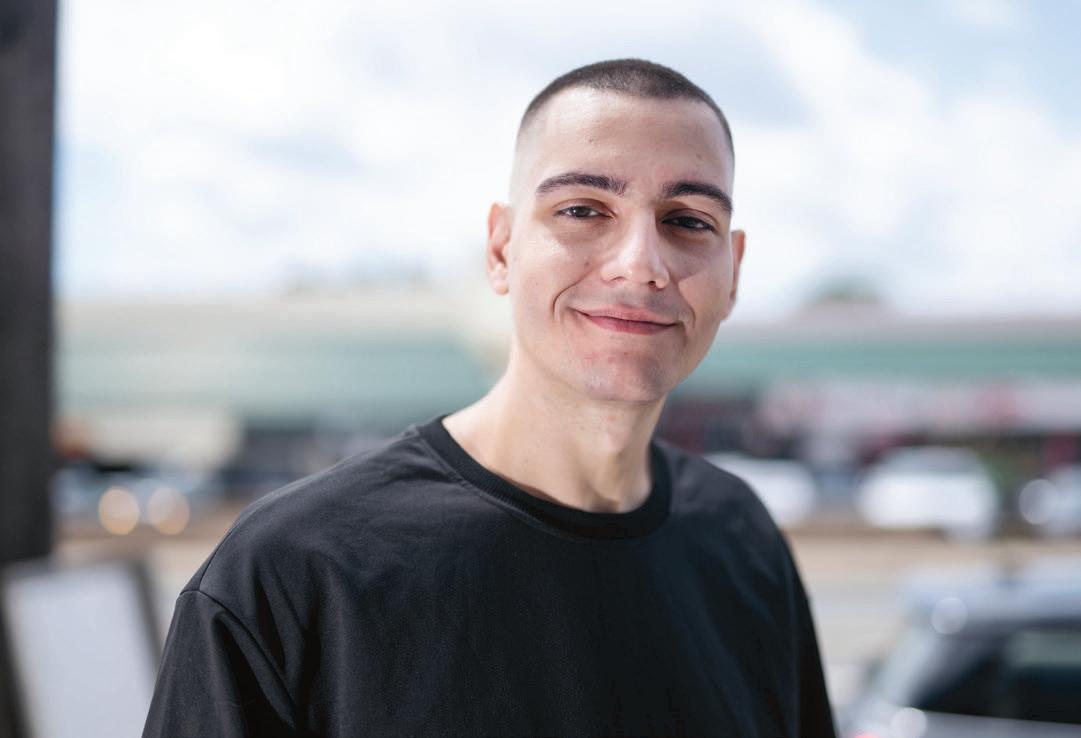

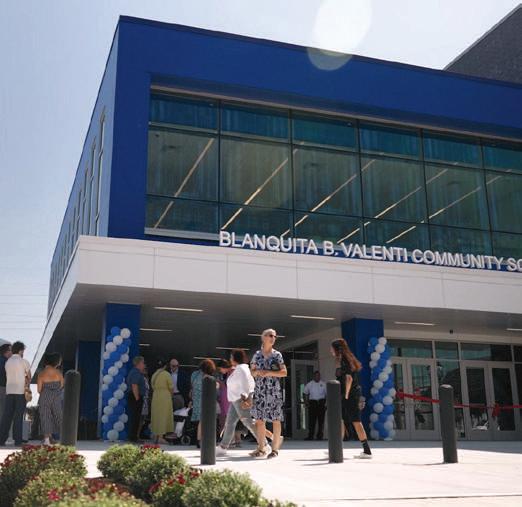
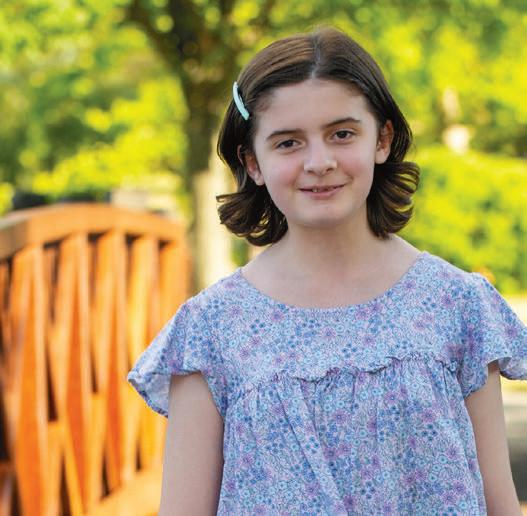

10. UROGYNECOLOGY: A WOMAN’S GUIDE. An evolving subspecialty treats conditions that are often ignored.
12. STANDING TALL. Surgery corrects a girl’s scoliosis—and inspires a future career.
14. A ‘SECOND CHANCE FOR TEENS.’ Youths with spinal cord injuries expand their horizons.
8. JOINT REPLACEMENT: WHAT TO KNOW. Expert answers to the most frequently asked questions.
16. MORE SERVICES FOR MENTAL HEALTH. Statewide efforts enhance behavioral health care programs.
18. UNLEASHED FROM EPILEPSY. Advanced MRI-guided therapies free a man from seizures.
20. COLLABORATING FOR HEALTHIER COMMUNITIES. Multiple programs improve quality of life in ways that affect outcomes.
22. HEALTHY AND HEARTY. A satisfying vegetarian chili recipe provides vital nutrients— and can feed a game-day crowd.

Heart disease is the No. 1 killer of both men and women in the U.S. However, women can sometimes be less likely than men to receive a timely and accurate diagnosis.
One reason for the disparity is that heart disease in women often manifests in ways that are much more difficult to diagnose than in men. A key example: Women are more likely to have a condition called coronary microvascular disease, or CMD.
Unlike the more familiar coronary artery disease, which affects the heart’s large arteries, CMD refers to dysfunction in small arteries that feed the heart—but it can be just as dangerous.
Until recently, there wasn’t a good way to diagnose CMD. Standard diagnostic methods such as an angiogram—a procedure performed in a catheterization lab to obtain images of coronary arteries—don’t adequately visualize the small blood vessels involved with CMD.
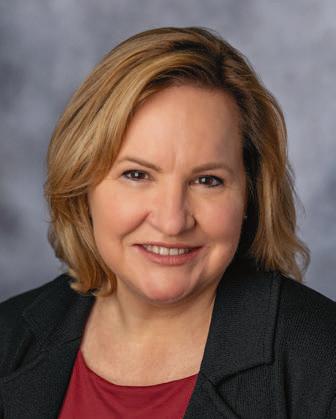
“Patients would come to the clinic with chest pain and often would have a stress test that suggests there’s a blockage,” says interventional cardiologist
Blood flow through small blood vessels in the heart can be just as important as flow through large vessels such as the coronary arteries.

Kimberly Skelding, MD, Division Chief of Cardiovascular Services at Jersey City Medical Center (JCMC). “But when they’d go to the catheter lab, we wouldn’t find any big vessel blockages on an angiogram. These patients could go in and out of the emergency room and have multiple clinic visits yet still not have an answer for why they continued to have chest pain.”
Patients knew that something was wrong. But their dangerous heart condition was essentially invisible to health care providers.
Now RWJBarnabas Health is offering a technology that allows doctors to quickly identify CMD and start a patient on appropriate therapies. Called the CoroFlow Cardiovascular System, the technology evaluates the health of small
Coronary microvascular disease is a disease of the endothelium, which is the lining of blood vessels—in this case, tiny blood vessels that nourish the heart. “The endothelium is one of the largest organs in your body, and its job is to keep blood vessels healthy,” says Kimberly Skelding, MD, Division Chief of Cardiovascular Services at Jersey City Medical Center. “When the endothelium is not functioning properly, it can prevent good blood flow to your heart and increase your risk of heart attacks.”
The heart’s tiniest blood vessels—some only the diameter of two strands of hair—are the last pathways for blood coursing through the heart. “We have many more tiny blood vessels than large ones,” Dr. Skelding says. “Even if blood is flowing through large vessels, when tiny ones aren’t functioning properly, proper amounts of blood don’t make it through the heart.”
Patients with CMD may experience chest pain and tightness; breathlessness; fatigue; and pain in the neck, shoulders, arms or back. “Both men and women have equal amounts of chest pain, but women tend to have more concomitant symptoms,” Dr. Skelding says—“more nausea, more shortness of breath, more fatigue.”
Risk factors associated with CMD include being female, smoking and having high blood pressure, high cholesterol, diabetes, obesity or sleep apnea. Research also suggests that people with rheumatologic and other inflammatory diseases run a greater risk of heart attacks from traditional blockages and a higher risk of CMD. “There are also likely genetic components to CMD,” Dr. Skelding adds.
blood vessels by assessing the flow of blood through them.
The technology is expected to be particularly helpful to women, who represent 80 percent of CMD patients.
“We know now that there are patients who have myocardial infarctions [heart attacks] and no obstruction in their big blood vessels but have so much disease in their small vessels that they truly did have a heart attack,” Dr. Skelding says— “just one that we couldn’t pick up with traditional tests.”
As with an angiogram, a CoroFlow assessment is done in a cardiac catheterization lab.
During the procedure, blood flow in small arteries is measured using specialized software and a thin wire placed in the arteries. Cardiologists use information from the test to determine whether small arteries are functioning properly. If CMD is diagnosed, patients
can be treated with lifestyle changes or medications to control risk factors and reduce symptoms.
RWJBarnabas Health is one of the few health systems in the region that offer the CMD-detecting test.
“It’s important to have the right diagnosis,” says Dr. Skelding. “We don’t have a magic bullet for microvascular disease, but we know that aggressively managing patients’ risk factors through steps such as lowering blood pressure; reducing cholesterol, with medication if needed; eating a healthier diet; and exercising—all of those measures help blood vessels function better.”
Taking cholesterol medication may be helpful even if you don’t have high cholesterol, Dr. Skelding says. “We know that cholesterol-lowering medicines also stabilize blood vessels,” she says. “So if your cholesterol is normal but your blood vessels are not healthy, these drugs can help improve the condition of those blood vessels.”
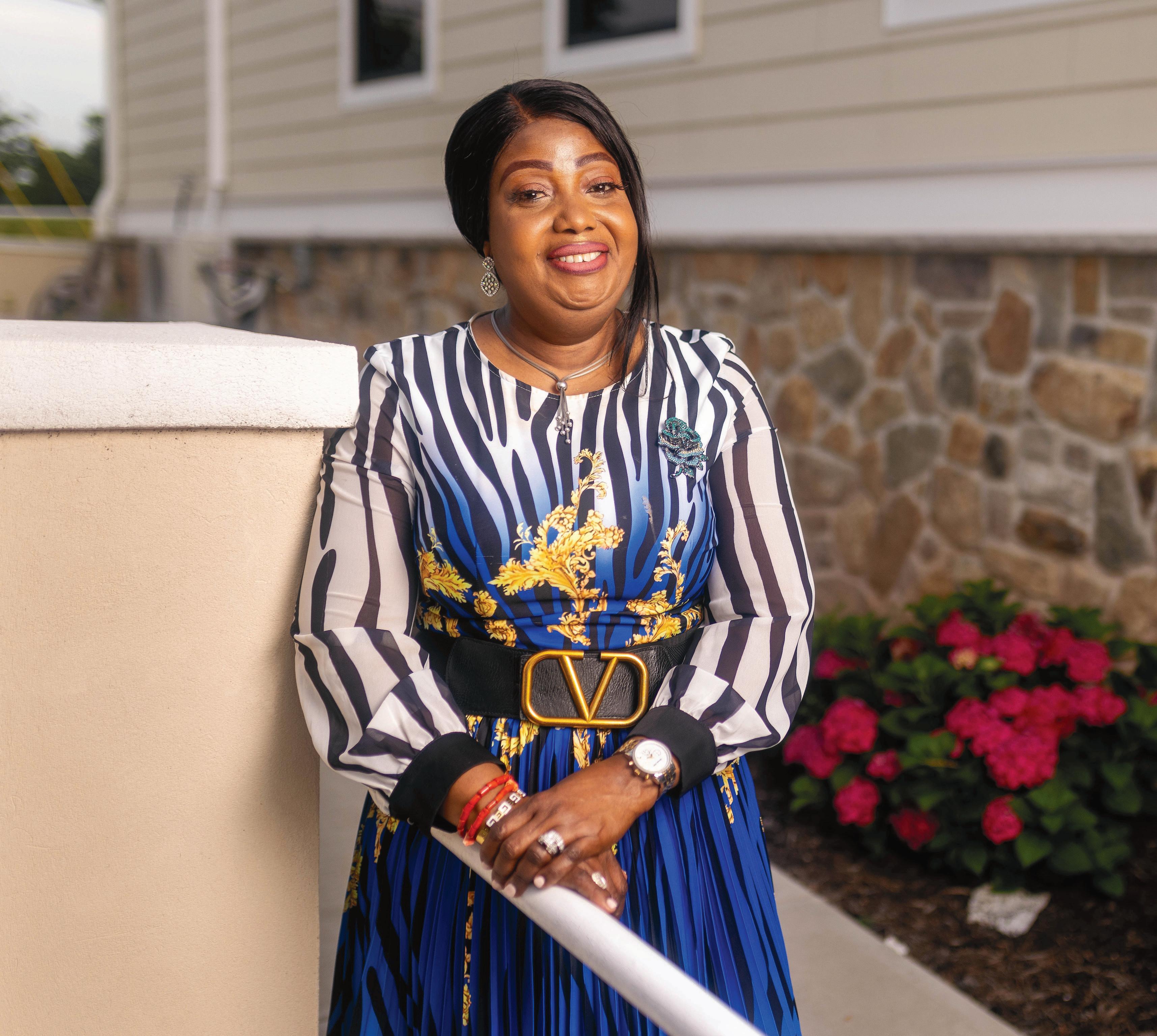
A WOMAN BEATS BACK LUNG CANCER THANKS TO ADVANCED, TARGETED THERAPY.
Cynthia Odeh, a nurse in Newark, was navigating an intersection in March 2022 when a car ran a red light, slammed into her vehicle and sped away.

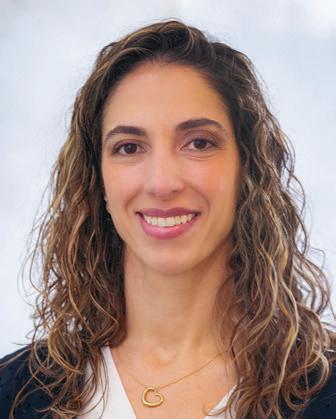
“‘This is the worst luck!’” she remembers thinking. But in one of life’s ironies, the collision may have saved her life.
Unknown to the 58-year-old mother of four grown children and lifelong nonsmoker, she had stage 2B lung cancer. CT scans during a precautionary trip to the emergency room revealed the threat.
“The doctor said my head and neck looked fine—but then asked if I smoked,” Cynthia says. “I said no,
RWJBarnabas Health, in partnership with Rutgers Cancer Institute—the state’s only NCIdesignated Comprehensive Cancer Center—provides close-to-home access to the most advanced treatment options. To schedule an appointment with one of our cancer specialists, call 844.CANCERNJ or visit www.rwjbh.org/beatcancer
To learn more about lung cancer care at RWJBarnabas Health, visit www.rwjbh.org/beatcancer

thinking, ‘Why is he asking me this?’”
The scans had shown an abnormal nodule on Cynthia’s left lung, and the physician told her to contact her primary care provider right away.
Each year, more than 2 million people worldwide are diagnosed with lung cancer, the leading cause of cancerrelated deaths. Most have a history of tobacco smoking, but about 10 to 20 percent of lung cancers occur in nonsmokers.
What’s more, lung cancer disproportionately affects people of color, who are more likely than white Americans to be diagnosed at a later stage and who may not receive treatment.
But despite challenges, there’s good news: “With screening, better diagnostic tools and improved treatments, the mortality rate from all cancers— particularly lung cancer—has steadily declined over the past 30 years,” says medical oncologist Missak Haigentz, MD, Chief of Thoracic and Head and Neck Medical Oncology at Rutgers Cancer Institute and Clinical Director of Oncology Integration at RWJBarnabas Health, who is part of the team that gave Cynthia her life back.
Cynthia’s journey toward healing began when her doctor referred her to Joanna Sesti, MD, Director of Thoracic Surgery, Northern Region, at RWJBarnabas Health. Fellowship-trained in minimally invasive and robotic thoracic surgery, Dr. Sesti specializes in chest-area conditions including lung and esophageal cancers, treating patients at Cooperman Barnabas Medical Center, Jersey City Medical Center and Newark Beth Israel Medical Center—all RWJBarnabas Health facilities.
“Dr. Sesti made me feel comfortable right away,” Cynthia says. “When she told me I’d need surgery, I was confident I was in good hands.”
During Cynthia’s surgery at Cooperman Barnabas Medical Center, Dr. Sesti first removed a wedge-shaped section of lung tissue and analyzed it under a microscope. Confirming cancer, she proceeded to take out the diseased lobe along with lymph nodes. “An advantage to this approach is that we condense diagnosis and therapy into one procedure,” explains Dr. Sesti.
Left with only four small incisions, Cynthia—like many of Dr. Sesti’s patients—was discharged from the hospital two days after surgery.
Cynthia followed up with Dr. Haigentz to determine whether she needed further treatment to prevent recurrence. “He’s very compassionate and knowledgeable,” she says. “He wanted to address this
cancer aggressively.”
Dr. Haigentz leads clinical trials for patients with lung and head and neck cancers at both RWJBarnabas Health and Rutgers Cancer Institute, the state’s only NCI-designated Comprehensive Cancer Center.
“The way we treat lung cancer has changed a great deal in the past 15 years,” says Dr. Haigentz. “We once viewed people with lung cancer as all having the same disease. Now we know that all lung cancers are not the same genetically.”
Medications can now target a cancer’s specific characteristics. As a result, lung cancer has seen the greatest recent declines in cancer deaths in the U.S. “There is tremendous hope for the future of cancer care,” Dr. Haigentz says.
Genetic testing of patients whose tumors are surgically removed lets physicians provide individualized treatment based on each tumor’s molecular characteristics. Cynthia’s tumor was found to have a mutation in a gene called EGFR. “This mutation is more common among nonsmokers with lung cancer,” says Dr. Haigentz.
He proposed four rounds of chemotherapy followed by three years of osimertinib, an oral medication. “Osimertinib is the first lung-cancertargeted medication to receive FDA approval for postoperative treatment of early-stage lung cancer,” says Dr. Haigentz. “A second targeted drug, alectinib, also received FDA approval for postoperative treatment of ALK [anaplastic lymphoma kinase]-positive lung cancer earlier this year.”
In combining the drug with chemotherapy, “we wanted the best treatment possible to reduce her risk of recurrence,” Dr. Haigentz says.
Chemotherapy behind her, Cynthia began taking osimertinib in December 2022. “The treatment continues to go well, and I feel good,” she says. “I love the fact that it’s a pill—no IV or needles. I’m back to work, traveling, going to church and doing all the things I enjoy.”
She sees Dr. Haigentz and Dr. Sesti for follow-ups and has CT scans twice a year. “We’re thrilled that she’s doing so well,” says Dr. Haigentz. “As a nurse, she helps so many people. We’re glad we were able to help her.”

AN ORTHOPEDIC SURGEON ANSWERS QUESTIONS THAT PATIENTS ASK MOST.
We all hope our joints will last forever. But as we age, we sometimes start to feel pain in our hips and knees. It may happen occasionally at first. Then it can become constant. Does joint replacement surgery await in your future?

If so, there’s good news: Thanks to continued advancements, joint replacement implants are lasting longer than in the past, and people in pain are able to get these surgeries at younger ages.
FRANK LIPORACE, MD
Here, orthopedic
surgeon Frank Liporace, MD, Senior Vice President, Musculoskeletal Service Line, RWJBarnabas Health, Northern Regions, and a member of RWJBarnabas Health Medical Group, offers insights into joint replacement surgery advances and answers some of patients’ most frequently asked questions.
When should I consider joint replacement surgery?
If you’re in significant pain, you should seek the care of an orthopedist. It’s rare to be recommended for surgery on your first visit. Instead, we prefer that most people begin with nonsurgical treatments to see if those bring any relief. These treatments may include injection therapy, physical therapy, oral medications or a combination.
How do you evaluate patients who have joint pain?
We start by asking about your family history. How long have you been in pain? How does pain affect your activities of daily living? What modifications have you had to make? We also ask about the location of your pain and will order X-rays or other imaging tests to find the root cause.
In addition, we’ll ask you to walk. If we see that your joint pain causes you to walk abnormally, it could be a sign that other structures in your body, such as your foot, ankle or spine, are affected as well.
What determines whether I need a partial or full joint replacement?
When it comes to the knees, a partial replacement today may last as long as a total replacement.
To qualify for a partial knee replacement, pain should be isolated to either the outside (lateral) or inside (medial) compartment of your knee. Partial knee replacement is not recommended for people who have ligament instability, obesity, severe osteoporosis, an autoimmune condition affecting the joints or a decrease in range of motion of 10 percent or more.
Partial hip replacements are rarer and typically are reserved for select patients who sustain a hip fracture.
What should I look for when choosing a doctor or hospital?
Look at the experience of the hospital and the surgeon. Ask your surgeon about their success rates and complication rates. Seek hospitals that have earned certification from professional organizations like The Joint Commission for hip and knee replacement surgeries. Also consider word of mouth. A referral from a friend will go a long way toward making you more comfortable with your surgeon.
How have joint replacements advanced?
We’ve seen significant advances over the past decade in three main areas:
1. Surgical approaches: The anterior approach to hip replacement has become more popular because it allows surgeons to remove less muscle, which may lead to faster recovery and less discomfort in patients. However, there is no single approach that works for every patient. The anterior, posterior and lateral approaches all have potential benefits and drawbacks depending on the patient’s anatomy and pain.
2. Pain management: We now use multimodal therapy with most patients. That means we use a combination of acetaminophen (Tylenol) and nerve medicine, while avoiding the use of narcotics whenever possible. This has improved patient comfort and allowed many patients to return home either the same day as surgery or the day after.
3. Technology: Numerous technologies— including manual instruments, surgical navigation systems and robotic-assisted surgery systems—help orthopedic surgeons ensure proper placement of prostheses, which leads to improved functionality and
While hip and knee replacements last longer on average today than in the past, there are times when a person may need to replace part or all of an original implant. This may be due to an infection around the implant, a nearby serious bone break or general wear and tear over time. Replacement procedures, called joint revision surgeries, generally entail a higher risk of complications than the original operations.
Surgeon experience matters, and patients at RWJBarnabas Health benefit from a team with deep expertise in joint revisions. “Our faculty performs hundreds of revisions a year,” says RWJBarnabas Health orthopedic surgeon Frank Liporace, MD. “Our length-of-stay and complication rates are nearly similar to those of primary joint replacement surgeries.”
One way to reduce the risk of needing a revision surgery: Attend follow-up appointments as scheduled. “I ask patients to return to me every one to two years after their initial joint replacement surgeries so I can check on the wear of their implant,” Dr. Liporace says.
longevity of implants. As a result, implants today can last 20 to 25 years or even longer.
What will the future of joint replacements look like?
We’re due for another wave of technology that will aim to reduce the wear and tear on joint implants and improve their longevity even further. We’ll also continue improving pain management protocols to help patients regain muscle function even faster.








hen we think about women’s health care, the specialty of obstetrics and gynecology (OBGYN) probably springs to mind.
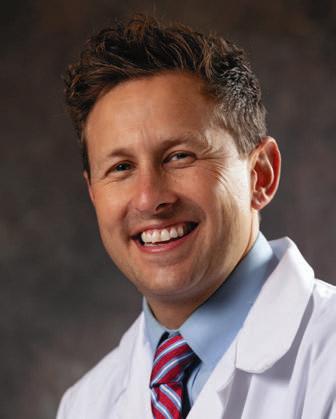
But while it’s important to see a gynecologist regularly starting around ages 13 to 15, women may need specialized care that goes beyond reproductive health for a variety of reasons:
• Women’s bodies are complex, and their intricate reproductive systems interact or connect with nearby organs and related bodily functions.
• Health care needs change throughout women’s lives—well past childbearing and menopausal years.
• Often, women develop problems in the pelvic area that are not solely gynecologic.
The multifaceted nature of women’s health has given rise to a subspecialty called urogynecology that can address diverse issues related to female anatomy.
Here’s what you need to know about this important medical field and the conditions it treats.
Urogynecology has been recognized as a discipline for decades but was only established as a certified subspecialty in 2011, with the first urogynecologists being board certified in 2013. The field doesn’t simply combine urology and gynecology but requires urogynecologists to undergo specialized education and training in an intensive fellowship on top of a general residency in either OBGYN or urology.
THE PELVIC FLOOR IS KEY
“Urogynecology is a subspecialty of both gynecology and urology that focuses on pelvic floor disorders [PFDs],” says Eric Liberman, DO, Director of Minimally Invasive Gynecologic Surgery at Cooperman Barnabas Medical Center (CBMC) and a member of RWJBarnabas Health Medical Group.
The pelvic floor is a funnel-shaped, sling-like area of muscles, ligaments and connective tissue between the coccyx (tailbone) and pubic bone that supports the bowel, bladder, uterus and vagina.
Urogynecologists are experts at diagnosing and treating PFDs with a variety of methods, including medications, devices and surgery, often working with other providers.
“As a gynecologic surgeon, collaboration with urogynecologists is beneficial because a patient’s symptoms may have more than one underlying cause,” says Dr. Liberman. “To achieve optimal patient outcomes, it’s important to consider the interactions of all organ systems and their effects on the patient’s symptoms.”
For example, a patient undergoing a hysterectomy for a large fibroid uterus and heavy menstrual bleeding may also have urinary incontinence and/or frequency that have been attributed to the fibroids. However, fibroids are not always the cause. “The patient may also
have an underlying bladder dysfunction that may benefit from a concomitant procedure,” Dr. Liberman says. “Conversely, patients may present to a urogynecologist with urinary frequency or incontinence complaints, and the root cause may be fibroids.”
About a third of women will experience at least one PFD in their lifetime.
Pregnancy and childbirth can contribute to PFD development, as can conditions that put pressure on the pelvic floor such as obesity, chronic constipation, heavy lifting, weak tissue and surgeries such as hysterectomies.
Among the most common PFDs are:
• Pelvic Organ Prolapse: One or more pelvic organs slip from their normal position and protrude into the vagina. Prolapse can often be managed with a pessary—a silicone device inserted into the vagina to support the uterus or bladder and rectum. Physical therapy may also be helpful as an adjunct or even a stand-alone treatment. Some cases may benefit from minimally invasive reconstructive surgery, which can be done laparoscopically or vaginally, with a typical recovery time of two to four weeks.
• Stress Incontinence: Pressure on the bladder from movement or activities such as coughing, sneezing, laughing or heavy lifting causes urine to leak. Treatment options include physical therapy, a surgically placed urethral sling or urethral bulking agents that are injected into the walls of the urethra to help strengthen its sides, allowing tighter seals that prevent leakage.
• Overactive Bladder (OAB): Bladder muscles tighten involuntarily, triggering a need to urinate urgently or often. Treatments for OAB include physical therapy and medications that suppress involuntary bladder contractions or relax certain muscles, increasing bladder capacity. Procedures such as injecting the bladder with
Botox or placing nerve-stimulating devices can also help.
YOU DON’T HAVE TO SUFFER PFDs are common among women, but that doesn’t mean they’re normal, and women don’t need to live with them. Older patients in particular often believe that conditions such as incontinence and pelvic organ prolapse are normal consequences of childbirth or aging and that they must “deal with it.” Women who are referred to urogynecologists are often relieved and say they wish they’d known of treatment options sooner.
COLLABORATION IS CRUCIAL PFDs often accompany or mimic gynecologic, urologic, gastrointestinal or other conditions, making collaboration between urogynecologists and other health care professionals important.
“For example, pelvic pain or urinary symptoms such as OAB, incontinence or chronic pelvic pain may be caused by fibroids—or by a PFD or interstitial cystitis [a chronic inflammation of the bladder],” says Dr. Liberman. “If a postmenopausal patient has had fibroids for many years but later develops increased urinary frequency or urgency, it’s important to investigate causes other than just fibroids.”
Dr. Liberman may refer such cases to a urogynecologist for urodynamic testing, which evaluates how well the bladder, sphincters and urethra store and release urine. A multidisciplinary collaboration helps determine the best treatment.
Surgeries are sometimes performed jointly by a gynecologic surgeon and a urogynecologist, which can spare patients from multiple procedures. “For instance, if a patient is having a hysterectomy and also has severe pelvic floor prolapse or urinary incontinence, a urogynecologist may work collaboratively to address the PFD or urinary incontinence,” Dr. Liberman says. “This way, the patient only has to undergo surgery and anesthesia once. Collaboration is key for the best patient outcomes.”
A GIRL’S SEVERE SCOLIOSIS LEADS TO SURGERY—AND INSPIRATION FOR A FUTURE CAREER.

In summer 2023, Jane and Walter Pabon of Sayreville noticed something different about their now-11year-old daughter, Meredith.
“Even when she was sitting up straight, it looked like there was a bump on one of her shoulders,” says Jane.
When the deformity grew larger, the Pabons took Meredith to the doctor, who made a startling diagnosis: Meredith had scoliosis, an abnormal sideways curve in the spine that often emerges in childhood or adolescence and is particularly common among girls.
Suddenly the Pabons needed specialized pediatric care that went beyond a normal trip to the pediatrician.
Meredith was referred to J. Andrew Bowe, MD, Chief of Pediatric Orthopedics at The Bristol-Myers Squibb Children’s Hospital (BMSCH) at Robert Wood Johnson University Hospital—part of the Children’s Health network at RWJBarnabas Health—and a member of RWJBarnabas Health Medical Group. BMSCH was named among the Best Children’s Hospitals for 2023-2024 by U.S. News & World Report, which ranked the hospital 34th nationally for pediatric orthopedics, and Dr. Bowe has expertise in conditions such as scoliosis.
Dr. Bowe took a progressive approach that started with conservative measures. These included seven months of physical therapy along with use of a specially fitted brace to hold Meredith’s spine in place. Such measures are often successful in holding scoliosis at bay but ultimately couldn’t forestall the worsening of Meredith’s spinal curvature. “She had a severe torso shift to one side because of progressive scoliosis,” says Dr. Bowe.
Meredith’s scoliosis wasn’t uncomfortable and didn’t make movement overly difficult. But it’s important to correct the problem at the right stage of development, Dr. Bowe notes.
“Teenagers won’t necessarily have a lot of pain,” he says. “But if scoliosis is left untreated and progresses into adulthood, they will see further worsening of their condition, increased deformity and the onset of back discomfort.”
In addition to these concerns, young patients tend to become self-conscious about their appearance when scoliosis becomes more obvious and clothing starts to fit less well, says Dr. Bowe.
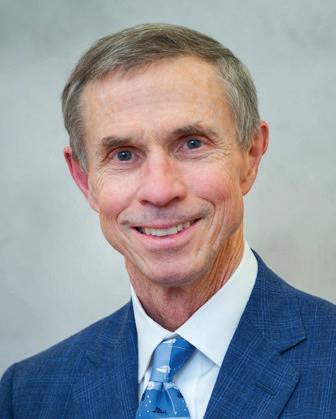
“During the initial tour and rundown of what was going to happen, they let us walk the floor and see the rooms where Meredith would be,” says Jane. “That put all our minds at ease.”
Meredith, who loves swimming and creating art, was especially struck by activities available to recovering patients. “When she saw there was a room with video games and art supplies, she was hooked,” Jane says. “That was something to focus on beyond the surgery.”
The successful seven-hour procedure in March 2024 involved both implanting two rods to straighten Meredith’s spine and performing a spinal fusion in which bone grafts are used to encourage new bone growth.
Meredith spent five days in the hospital but quickly began recovering. “Even though it was a major surgery, she was up and moving the first day,” says Jane.
During recovery, Meredith was struck by something else: the impact of interactions with child life specialists. “These are professionals who try to allay some of the angst that children may experience by engaging them and getting them to worry less about treatment,” says Dr. Bowe.
“We use a lot of different interventions to help the child and family cope,” says Barbara Romito, Director of Child Life and FamilyCentered Care at BMSCH. “These include teaching children about their condition in an age-appropriate way, preparing them for surgery and guiding them through pain management techniques such as relaxation, guided imagery and distraction.”
Physical therapy (PT) often plays a key role in treating scoliosis. That’s why RWJBarnabas Health offers a highly specialized PT technique called the Schroth method that helps children counteract spinal curvature and realign posture.
“It addresses scoliosis on a threedimensional level,” says Karen Cohen, MPT, BSPTS-C2, a Schroth therapist at Children’s Specialized Hospital (CSH). “While scoliosis is a curvature of the spine, there’s also a rotational component, and this therapy addresses that.” A certified therapist helps patients locate and retrain muscles involved with posture to elongate and straighten the spine while doing special breathing exercises.
Schroth-certified therapists are available at CSH outpatient centers in East Brunswick and Toms River, and at Cooperman Barnabas Medical Center in Livingston.
One or two child life specialists came to Meredith’s room each day to talk and answer questions, get her walking, encourage activities and allow her parents to occasionally step out.
The support made a big impression on Meredith—in fact, she is considering becoming a child life specialist herself someday, beginning as a volunteer in the department. Volunteers can start at age 18. “She is counting down until that birthday,” Jane says.
The family took all these concerns to heart and scheduled Meredith for spine surgery at BMSCH. She and her parents were understandably nervous, but a trip to the hospital beforehand helped calm their anxieties.
The activity lounge in the adolescent unit and a playroom in the pediatric unit offer settings for recreational activities. “Our goal is to normalize the hospital experience and offer emotional support to the entire family,” Romito says.
Back home, Meredith’s recovery rapidly progressed. “Within a month or so, she was back to normal,” Jane says. “You never want to put your child through surgery, but we realized this was the best time in the best place with the best surgeon. I wouldn’t change a thing.”

Isaac Lima of Roselle Park remembers the 2021 injury that severely limited his movement and required him to use a wheelchair.
He was a 14-year-old cheerleader and a flip went terribly wrong, causing him to land on his head. He tried to stand—or even move—but couldn’t. “I kept telling myself, ‘Get up, get up,’” he says. “In the ambulance, I remember screaming, ‘What happened to me?’”
Isaac had sustained a spinal cord injury and spent four inpatient months at Children’s Specialized Hospital (CSH), where he embarked on the arduous process of rehabilitation.
“At first, I was in denial and depressed, wanting to shut out the world,” he says. A fellow patient changed his outlook. “I saw a boy who
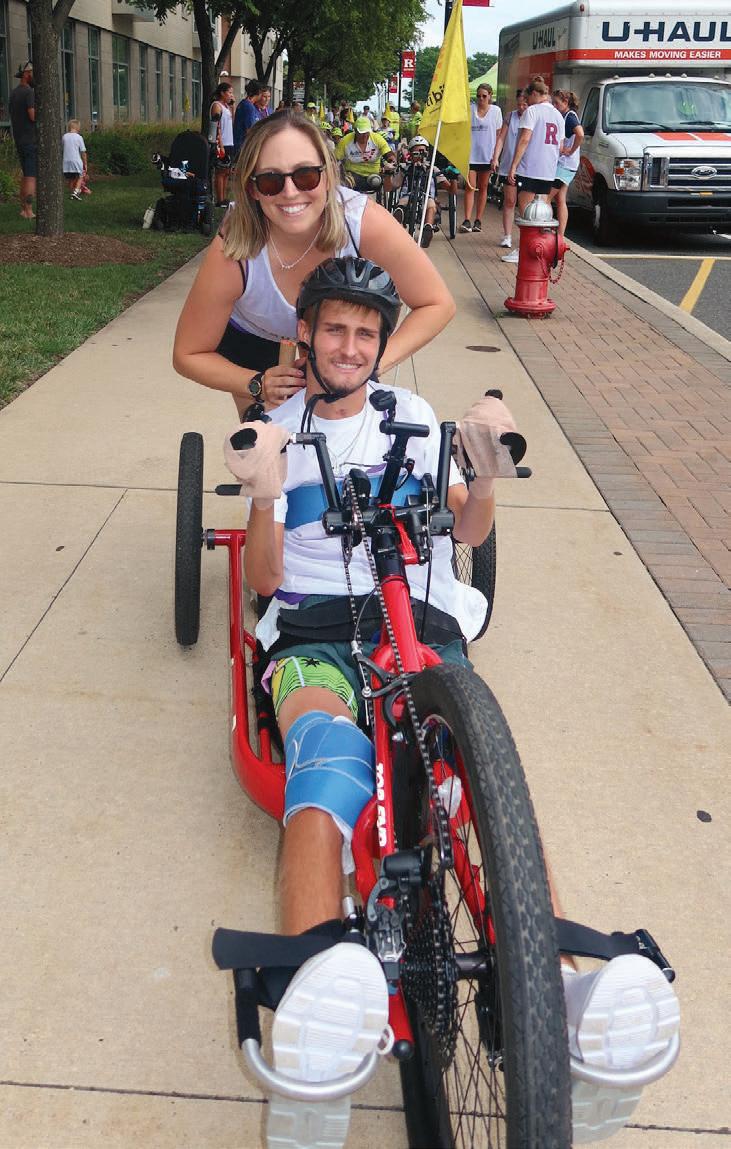
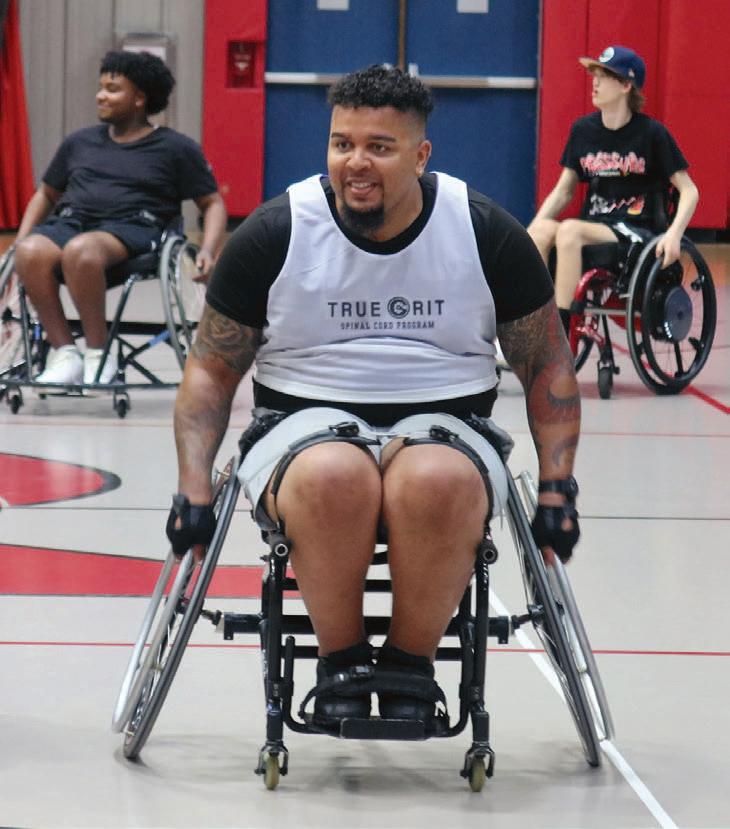
was in a coma start walking after just a month,” he says. “That inspired me to think, ‘I can’t sit still. I need to get on with life.’”
Isaac credits staff at CSH for helping him navigate a challenging journey.
“My care team was definitely a team of angels in disguise,” he says. “They never gave up on me.”
Three years later, the CSH team continues to support Isaac, now 17, and other young patients with spinal cord injuries through a unique and innovative new initiative from CSH and the Rutgers School of Health Professions called the True Grit Spinal Cord Program. The groundbreaking program is designed to empower youth
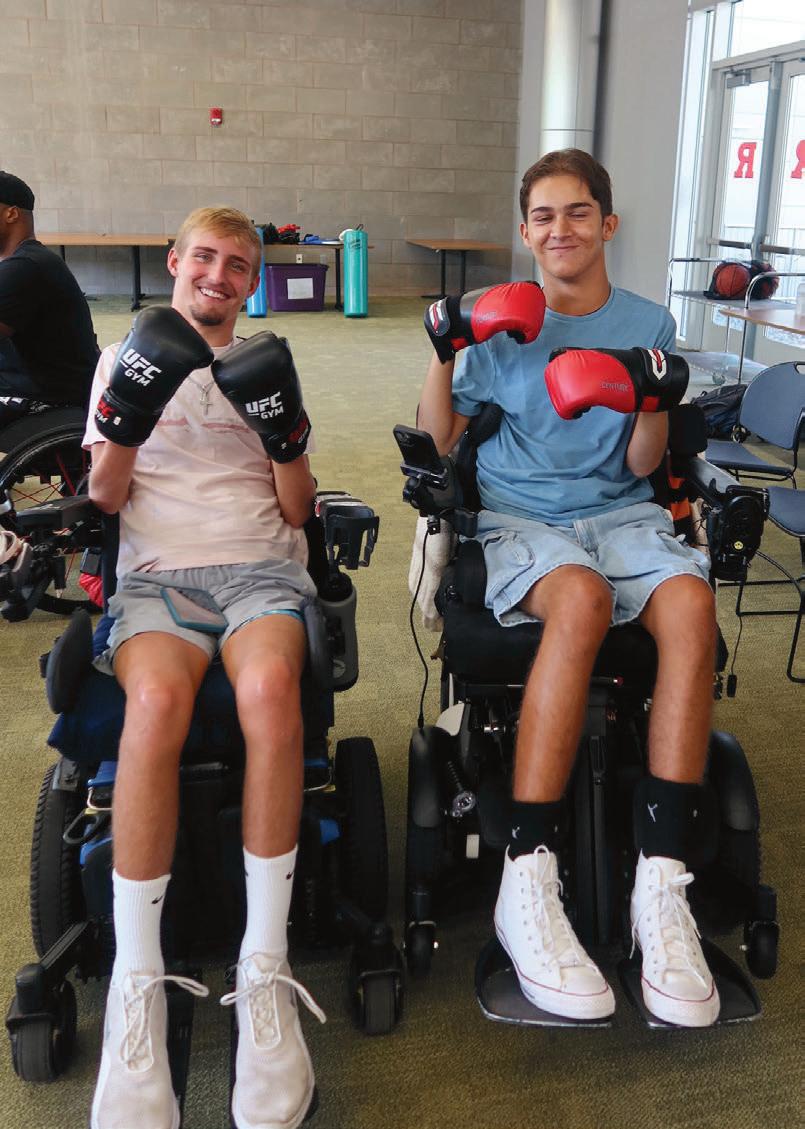

ages 16 to 21 through an immersive fiveday sleepaway experience that helps participants gain independence, skills, confidence and a sense of community.
“We wanted a program with peer support where teens could explore entering the workforce, going to college and trying new leisure activities and sports,” says occupational therapist Kassandra Boyd, OTD, OTR/L, Clinical Coordinator of Spinal Cord Programs at CSH. “I worked in inpatient rehabilitation for 10 years, and there was always a sense of needing to do more for teens with spinal cord injuries.”


Boyd got a doctorate specifically “to address this second chance for teens,” she says. Adolescents with spinal cord injuries are often isolated at a time when they’re defining who they are, striving for independence and developing ideas about the future. But few if any programs existed nationwide to support them.
True Grit provides opportunities for these youths to gain self-sufficiency, improve quality of life and expand their horizons through staying in a dorm on the Rutgers University Livingston campus with support from both therapists and peers. Six teens attended the program’s first annual residential session in July.
A typical day begins with breakfast in the dorm dining hall—in itself an accomplishment for teens who are often away from family members or other familiar caregivers for the first time. The rest of the day includes group activities from adaptive

sports like boxing, yoga, basketball, baseball, pickleball and hand cycling to workshops on vocational skills, sexuality, adaptive driving and college life. The program also includes individualized physical and occupational therapy along with psychotherapy.
Just as important is peer support. “What they learn from each other is remarkable,” Boyd says.
“Anybody who has a strength is able to teach others. That’s really the magic of the week.”
Isaac was nervous about attending at first. “But after the first day, I was
comfortable and it was immediately easy to form friendships,” he says.
“Every day we got closer and closer.” Bonds extended to both participants and staff. He especially connected with a caregiver who coached him on activities from self-care to cooking.
“When it was time to leave, we were both crying,” Isaac says. “I can’t wait until next year!”
SCAN THIS QR CODE TO LEARN MORE ABOUT THE SPINAL CORD REHABILITATION PROGRAM AND THE TRUE GRIT SPINAL CORD PROGRAM.
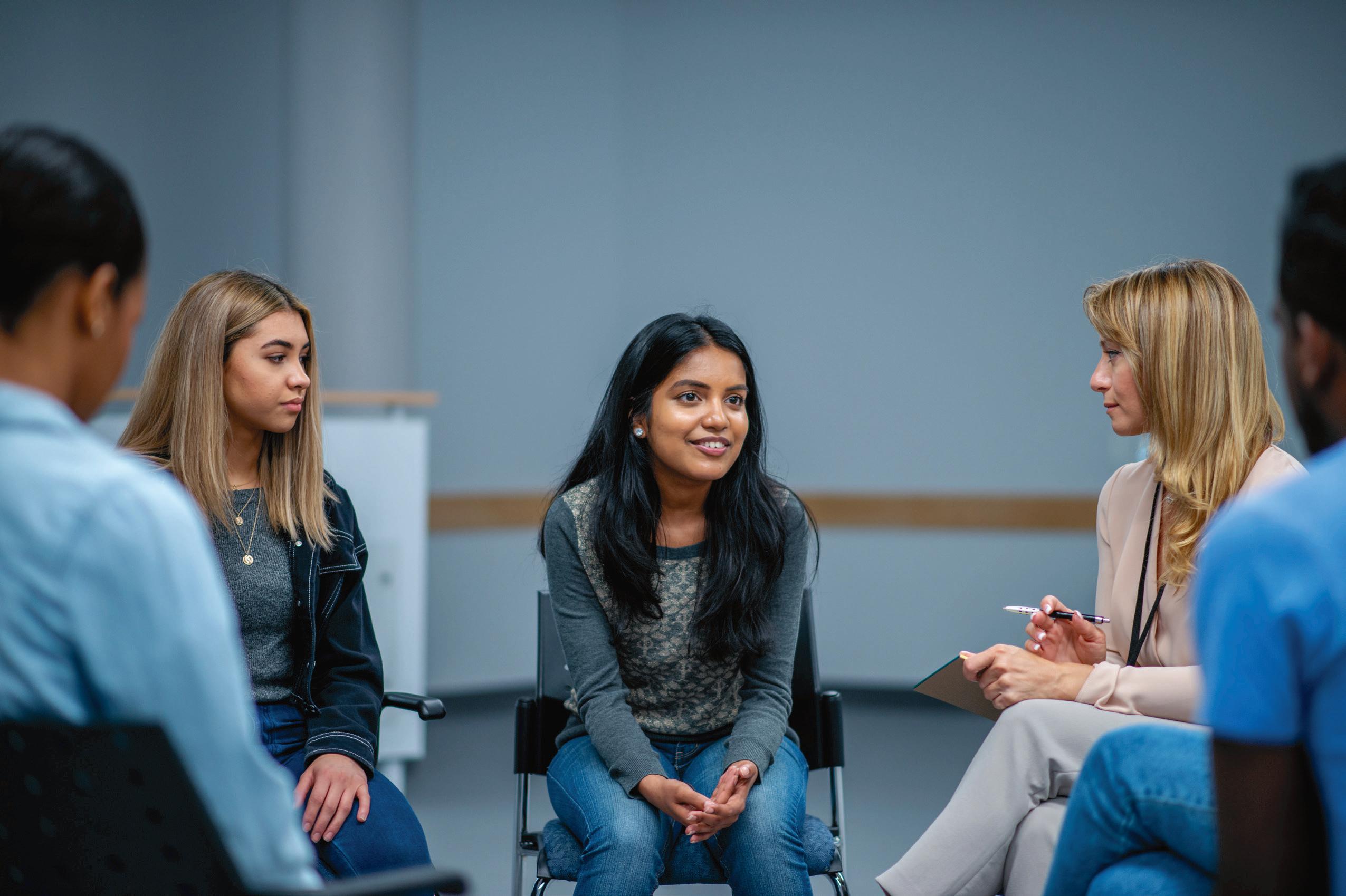
STATEWIDE EFFORTS INCREASE AND ENHANCE BEHAVIORAL HEALTH CARE PROGRAMS.
It’s a trend that predates COVID-19 but that health care providers have increasingly noted since the pandemic: There’s a growing need for mental health services.
Organizations such as the Centers for Disease Control and Prevention note a steep rise in rates of depression, anxiety, loneliness and suicide. Providers also see these trends locally as they are caring for more and more patients.

FRANK GHINASSI,
PHD
“Young people have been hit especially hard,”
says Frank Ghinassi, PhD, Senior Vice President of Behavioral Health Services at RWJBarnabas Health and President and Chief Executive Officer of Rutgers University Behavioral Health Care (UBHC). “The impact of this hidden health crisis is becoming clear, and it’s critical that we invest resources to address the mental health needs of our communities.”
In response, RWJBarnabas Health and UBHC together have recently established or enhanced a number of programs, initiatives and facilities throughout the state such as a new Center for Recovery and Well-Being in Plainfield; Coordinated Specialty Care/First Episode Psychosis Programs in Edison and Cherry
Hill; and TMS (transcranial magnetic stimulation) in Piscataway. RWJBarnabas Health, together with UBHC, is a leading provider of integrated mental health and substance use treatment services, serving over half a million people each year.
Some new initiatives have benefited from recent grants that the New Jersey Department of Human Services awarded to Monmouth Medical Center (MMC) and UBHC to provide services to people in immediate need of crisis intervention and stabilization.
“The expansion of our offerings increases access to quality behavioral health care and further strengthens our services,” Ghinassi says. “These enhancements ensure that those in need
Traditionally considered a last-resort treatment, electroconvulsive therapy (ECT) is increasingly seen as one of the most powerful tools available to treat depression, especially when standard methods prove insufficient.
The treatment is available at Trinitas Medical Center, building on an ECT program that began in 2020 at Clara Maass Medical Center and RWJBarnabas Health Medical Group. Though its use is sometimes constrained by misconceptions, ECT is safe and effective as both an acute and maintenance treatment for depression and certain other neuropsychiatric disorders. It can be especially beneficial for behavioral health patients who:
• Have depression that hasn’t been relieved by multiple medication trials or who haven’t tolerated medication
• Responded well to ECT in the past
• Are at risk for suicide
• Are pregnant or postpartum and want to avoid antidepressants
• Are older and don’t respond well to medications or have become more sensitive to side effects
• Need a rapid, definitive response to treatment
receive the comprehensive support they deserve.”
Other increasingly important behavioral health programs include:
Clara Maass Medical Center’s Behavioral Health Services introduced a new Intensive Outpatient Program (IOP). The program offers services grounded in evidence-based practices and focuses on treating general mood and anxiety disorders.
Participants attend IOP sessions three days a week for an average of four to six weeks. Each week, participants receive intensive group therapy, psychoeducation, individual and family therapy and medication management. The program is intended for patients 18 or older who are experiencing symptoms of anxiety or depression without cognitive impairment, active psychosis or active suicide risk.
At MMC, a Child and Adolescent Crisis Diversion Program focuses on meeting the emotional, behavioral and psychiatric needs of children and adolescents from ages 5 to 17, along with the needs of their families.
The program provides rapid access to outpatient mental health services in a
safe, compassionate and trauma-sensitive environment that promises to both decrease the need for higher-level care and promote community safety.
A multidisciplinary team of highly qualified, caring mental health professionals, including advanced practice nurses, licensed clinicians, case managers and support staff, offer specialized experience working with children and families. The team collaboratively strives to help youth acquire skills, strategies and techniques for managing symptoms or concerns in healthy and sustainable ways.
Services include biopsychosocial assessments, medication management, psychotherapy, crisis counseling, family and group therapy, coordination of care and referrals for ongoing services.
UBHC recently unveiled New Jersey’s first youth mental health facility backed by a university or college. Called the Brandt Behavioral Health Treatment Center and Retreat, it combines behavioral health care with evidence-based scholarly research, strengthens the partnership between health care professionals and the communities they serve and helps train the next generation of providers.
Two buildings—
the Blau Wellness Center and the Retreat—include rooms for art and music therapy along with a mind-body studio that accommodates dance and yoga therapies. The Retreat includes private rooms for up to 16 guests and a fitness center. Situated near the university’s agricultural research facility, the pastoral site borders horse pastures of the Rutgers Equine Research Facility.
Jersey City Medical Center recently expanded its psychiatric emergency services, growing from six to eight adult rooms and adding two pediatric rooms. Rooms are specifically designed for calm and relaxation, with soothing colors, safe furniture and televisions in each room.
An off-unit family consultation room provides a dedicated space for family members to work with the clinical team by, for example, providing information to medical and mental health clinicians.
Behavioral health care services treat a wide range of issues, including:
• Depression and social isolation
• Mood swings
• Hyperactivity, restlessness or impulsivity
• School avoidance
• Anxiety and panic
• Behavioral difficulties
• Poor social skills
• Loss of motivation or energy
• Auditory or visual hallucinations
• Appetite or sleep disturbances
• Suicidal thoughts
• Family conflict
• Trauma
• Substance abuse
• Thoughts of self-harm
• Poor self-esteem/self-image
• Gender identity
• Grief and loss
To learn more about behavioral health services, visit www.rwjbh.org/behavioralhealth .


FROBERT GROSS, MD, PHD
or seven years, epileptic seizures have kept Christian Trucchio on “a leash,” he says, that has prevented him from truly living. Now, thanks to advanced technology at Robert Wood Johnson University Hospital (RWJUH), Christian is on his
way to trading that leash for a new lease on life.
Christian was the first patient at RWJUH to benefit from the ClearPoint Navigation System. This advanced system provides surgeons doing neurological procedures with stereotactic guidance—a type of 3D MRI (magnetic resonance imaging).
The ClearPoint system helps with the planning and execution of neurological procedures. During surgery, it allows highly accurate placement or operation

of instruments or devices, reducing the chances of damaging healthy brain tissue. The system’s latest software optimizes ease of use for clinicians, enhancing the visualization of medical images, providing new trajectory planning capabilities and introducing new workflow tools for clinical trials.
RWJUH surgeons used ClearPoint technology to treat Christian’s epilepsy with a laser ablation procedure.
Laser ablation is a minimally invasive technology that uses light energy to target an area of the brain responsible for triggering epileptic seizures. Laser beams are delivered to the target area using an MRI-guided probe that’s directed through a 3-millimeter hole in the skull. Energy from the probe heats the target, destroying unwanted tissue and leaving healthy tissue unharmed.
RWJUH is home to the state’s first intraoperative MRI, which allows the ClearPoint system to use real-time MRI images. Viewing MRIs during surgery eliminates the need to pause the procedure and take the patient out of the operating room for scans. This can shorten surgeries and reduce patients’ potential exposure to nonsterile surroundings.
“The ClearPoint system allows neurosurgeons to achieve the highest level of consistent, accurate precision of any tool available,” says Christian’s surgeon, Robert Gross, MD, PhD, Chief of Neurosurgery at RWJUH and Senior Vice President for Neurosurgical Services at RWJBarnabas Health. Dr. Gross also serves as joint chair of the Department of Neurosurgery at Rutgers Robert Wood Johnson Medical School and Rutgers New Jersey Medical School. “ClearPoint allows direct visualization of whatever one is attempting to insert into the brain as it gets to its intended target, using the power of MRI,” Dr. Gross says.
In addition to enabling laser ablation, ClearPoint can be used in other ways such as supporting deep brain stimulation and delivering gene and cell therapies to the brain. “Its uses span Parkinson’s disease, Huntington’s disease, epilepsy, brain tumors, psychiatric disorders, pain, Alzheimer’s disease and others,” says Dr. Gross.
Christian’s family has a history of epilepsy: Both his mother and grandmother experienced seizures, and his mother’s death at 47 may have been linked to her condition.
Shortly after her death, Christian’s long, difficult journey with epileptic seizures began. Over a brief period, he also lost his grandmother and uncle along with the family cat. The high stress may have helped trigger his seizures. Episodes became so severe that he lost two jobs, leading his family to move from New York City to New Jersey.
While doctors initially could manage his condition with medications and he was able to return to work, his seizures grew increasingly worse. By the time of the COVID-19 pandemic, seizures that had occurred once every two to six months were happening as often as once every two weeks, Christian says.
Once in New Jersey, Christian found a neurologist at Cooperman Barnabas Medical Center who recognized that Christian’s medication regimen was becoming less effective. He thought Christian might be a good candidate for laser ablation and referred him to Dr. Gross.
After meeting with Dr. Gross, Christian became confident that laser ablation was right for him. “He said laser ablation was a minimally invasive option with relatively fast recovery time,” Christian recalls.
Dr. Gross performed the procedure in April 2024. Christian has effectively been seizure-free ever since. “I feel much more mental clarity now,” he says.
His doctors continue to monitor him and hope to reduce the number of medications he takes. “The goal is no seizures and less meds,” Christian says.
Now on disability, Christian looks forward to returning to work and a more active lifestyle that includes skating, handball and a greater variety of daily activities.
“I really want to drive again,” he says. “But I’m seeing life through a different lens now. I am more positive than I have ever been. If not for my doctors, I’m not sure how much longer I could have gone on.”
MULTIPLE PROGRAMS WORK TO IMPROVE QUALITY OF LIFE IN WAYS THAT AFFECT OUTCOMES.
At RWJBarnabas Health, building and sustaining a healthier New Jersey means more than caring for the sick and injured. It also means working with local communities to address key socioeconomic, environmental and behavioral factors known to impact more than 80 percent
of health outcomes.
In cities and neighborhoods throughout the state, RWJBarnabas Health has partnered with local leaders and like-minded organizations to increase access to resources including healthy food, lower-cost medication and high-quality education opportunities.

Such initiatives are part of the health system’s Social Impact and Community Investment practice, which leverages a broad range of assets to advance a culture of health, improve quality of life and promote health equity through innovative, evidence-based programs. Here are several recent initiatives:

SAINT JAMES HEALTH 340B RETAIL PHARMACY AND FOOD ‘FARMACY’
RWJBarnabas Health, in partnership with Saint James Health Federally Qualified Health Center (FQHC) in Newark, recently opened a new 340b retail pharmacy that provides discounted medication and education to patients at the Saint James primary care office on Lafayette Street. A food “farmacy,” modeled after a similar program that Jersey City Medical Center developed for residents in Hudson County, was also opened in Newark. The “farmacy” offers fresh produce from
locally sourced farms along with refrigerated and shelf-stable items to improve access to healthy provisions in an area identified as a food desert. Nutrition counseling and healthy eating education are also provided. Both programs help address issues of health equity, access to care and health outcomes in the city of Newark, serving patients of Saint James Health FQHC with help from state funding, local government and other community partners.
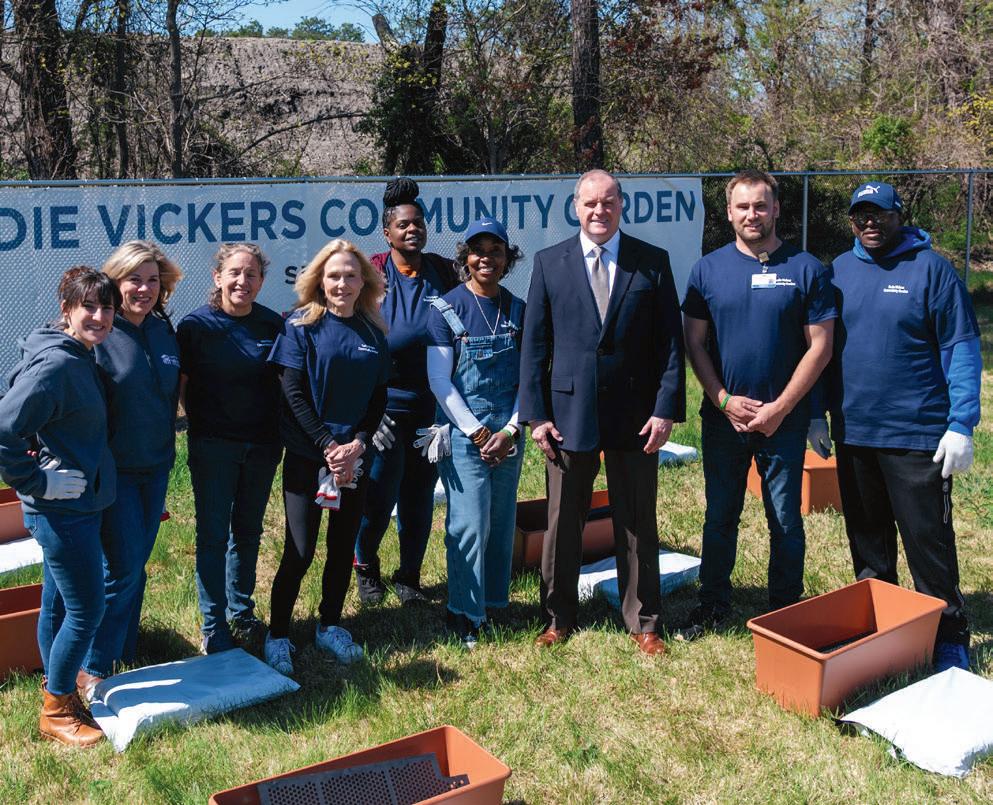



Community Medical Center (CMC) and RWJBarnabas Health, with the Sadie Vickers Community Resource Center, began work in April to create a community garden in South Toms River. Volunteers set up 100 earth boxes designed for growing thousands of pounds of fresh fruits and vegetables. Harvests are distributed through farmers’ markets, food pantry programs and community partner organizations. The program provides not only healthy foods in areas that lack supermarkets but also nutrition and wellness education.
In 2023, Robert Wood Johnson University Hospital (RWJUH) Hamilton also opened a new community garden at Bromley Field and Sports Complex in Hamilton Township. The garden expands RWJUH Hamilton’s Farm to Family initiative, which provides nutrition
education, health screening and food security programs hosted at local community centers.
Local families adopt Farm to Family Community Garden plots for a year and learn to grow healthy produce using sustainable practices. The garden is located alongside RWJUH Hamilton Community Field, opened in 2021 to promote children’s physical and mental health, with both projects built in collaboration with local government, businesses and organizations. The gardens at CMC and RWJUH Hamilton join numerous other gardens that RWJBarnabas Health supports statewide.
To learn more about RWJBarnabas Health, visit www.rwjbh.org .
The recently opened Blanquita B. Valenti Community School is a key component of a sweeping $750 million project funded by RWJBarnabas Health. The project includes development of the state’s first freestanding cancer hospital—the Jack and Sheryl Morris Cancer Center, slated to open in 2025. The $55 million, 127,000-squarefoot elementary school is built on land donated by RWJBarnabas Health Board of Trustees founding chair Jack Morris. It was developed in collaboration with the city, Middlesex County, Rutgers Cancer Institute and DEVCO (New Brunswick Development Corporation), replacing a school that had stood at the site of the new cancer center.



Colder-weather cravings for warm, hearty foods are often satisfied with ingredients that sabotage health, such as refined flours and sugars or cheeses and meats high in saturated fats. Solution: Shift to plantbased cooking.
Working more fruits, vegetables, beans, grains and other animal-free foods into daily meals and snacks not only helps you avoid unhealthy items but also increases your intake of important nutrients such as fiber, which many Americans’ diets lack. Fiber helps stave off problems including high cholesterol, digestive issues and inflammation, which is linked to higher incidence of obesity, diabetes, heart disease and colorectal cancer.
You’ll also get phytonutrients including antioxidants such as beta-carotene, lycopene and anthocyanins. Phytonutrients combat inflammation and perform molecular cleanup that reduces toxins capable of triggering illnessrelated genetic mutations.
Even better: Hearty plant-based recipes like the one at right taste great.

Servings: about 6-8
Throw this hearty chili together for a game-day gathering of friends and family or freeze leftovers for future meals. A one-pot meal, it includes everything you need from different plant-based food groups, including vegetable-based protein and fiber.
INGREDIENTS:
• 1 tablespoon olive oil
• 1 medium onion, diced
• 1 red or green bell pepper, chopped
• 5-6 cloves garlic, chopped
• 1 jalapeño pepper, chopped
• 2-3 tablespoons chili powder
• 1 tablespoon cumin
• 2 teaspoons dried oregano
DIRECTIONS:
• 1 28-ounce can crushed tomatoes, fire roasted if available
• 1 can low-sodium black beans, rinsed, drained
• 1 can low-sodium red kidney beans, rinsed, drained
• 1 can yellow corn, rinsed, drained
• 1 cup water or vegetable broth
• 1 teaspoon pepper
• Salt to taste
• Gather all equipment and ingredients. Heat the oil in a medium/large pot. Add the onion, bell pepper, garlic and jalapeño. Cook for about 5 minutes or until the vegetables start to sweat.
• Add the chili powder, cumin and oregano. Stir to combine. Pour in the tomatoes, beans, corn and water. Bring the mixture to a boil, then reduce to a simmer and cook for about 30 minutes or until heated through. Taste and season with the black pepper and salt as needed.
• Serve by itself or over a grain such as quinoa or short-grain brown rice.
Make a plan with New Jersey’s top TAVR program.
RWJBarnabas Health offers the state’s most innovative valve replacement procedures—our patients experience less pain, fewer complications, and quicker recovery time, often returning home the day after the procedure. Managing your heart health is a lifelong journey; know that TAVR is equally an interventional cardiology procedure as it is a surgical procedure. Trust the health system with the largest network of providers, hospitals, and adult and pediatric cardiac surgery programs in the state for all of your heart’s needs. Your heart’s in the right place at RWJBarnabas Health. Make plans at rwjbh.org/tavr
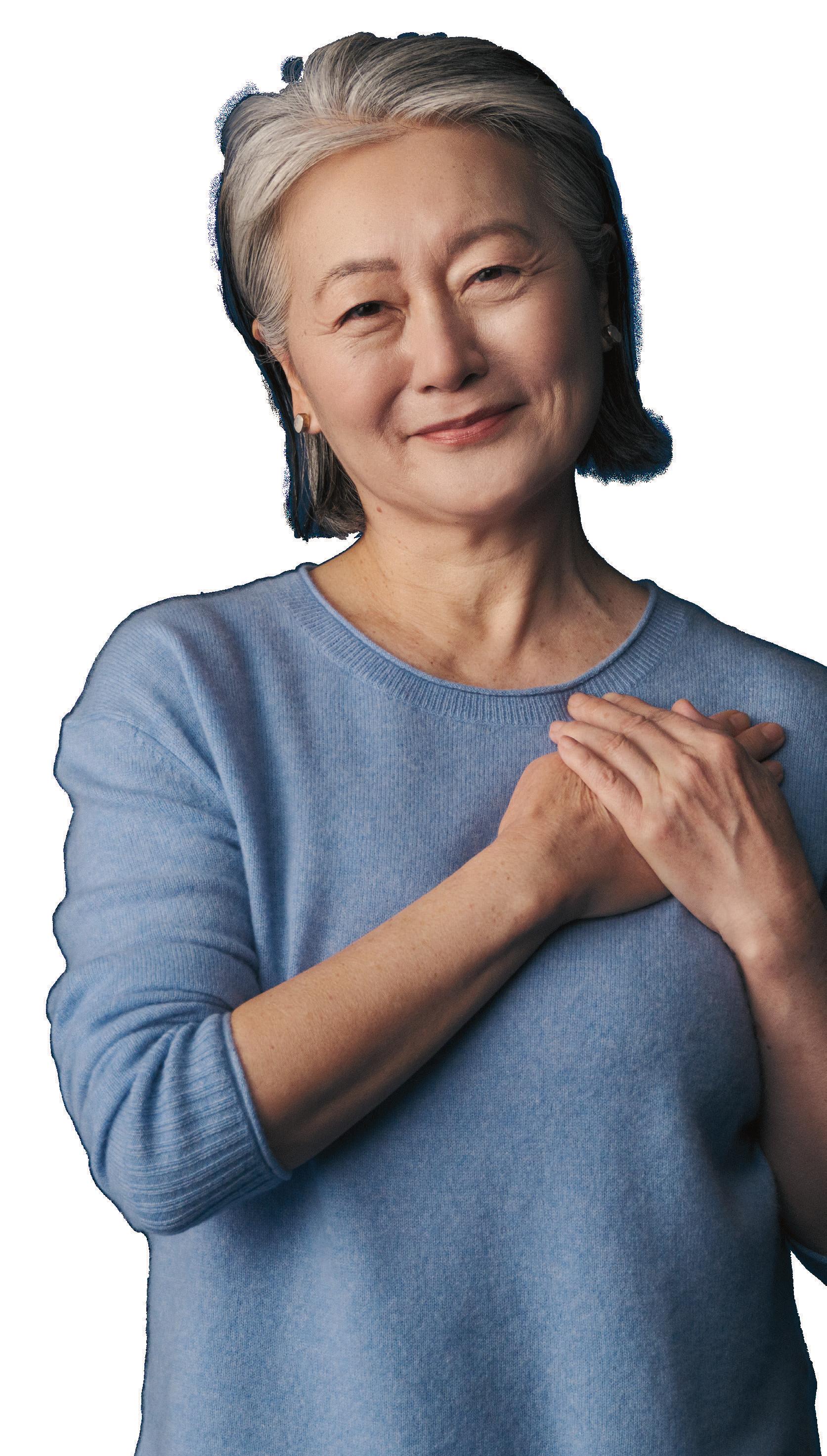

95 Old Short Hills Rd
West Orange, NJ 07052
Advanced, comprehensive and compassionate Cancer Care.
RWJBarnabas Health, together with Rutgers Cancer Institute, the state’s only National Cancer Institute-designated Comprehensive Cancer Center, offers the most advanced, patient-centric cancer care for adults and children. Our nationally renowned, multidisciplinary care teams ensure a compassionate, comprehensive approach, creating individualized cancer treatment plans for our patients, who have access to blood and marrow transplant, CAR T-cell therapy, innovative clinical trials, and immunotherapy procedures - all close to home. Together with our NCI Consortium partner, Princeton University, the longest NCI Consortium Cancer Center relationship in New Jersey, we are driving cutting edge research and advancing scientific discoveries into clinical practice. Visit rwjbh.org/beatcancer or call 844-CANCERNJ
